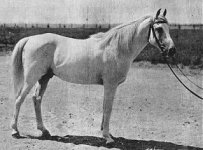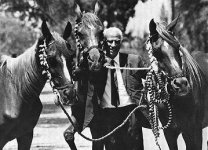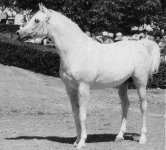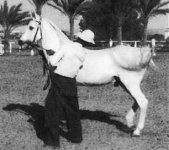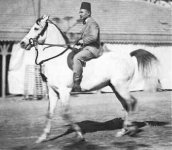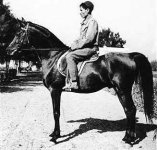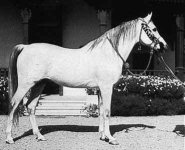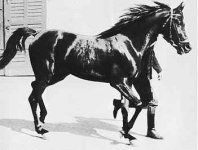♘امیرحسین♞
♘ مدیریت انجمن اسب ایران ♞
تقدیم به دوست عزیزم سهراب که در زمینه اسب اصیل زحمت زیادی میکشند, امیدوارم مطالعه این متن کمک کوچکی به افزایش اطلاعات در زمینه اصیل باشد
photo:The racehorse El Deree
During the 20s Egypt, like many European countries, was trying to improve its agriculture. This included the improvement of livestock through sytematic breeding. As in Europe, it included stallion testing to enable private breeders to make use of exceptional sires. In Egypt this was all seen to by the R.A.S. which has started the project in 1910 with the establishment of a central stud farm at Bechtim.It was decided to use Arabian horses with two things in mind: to breed stock for upgrading local horses that were suited to the climate and to the people’s need; and to preserve an historic breed, the cultural heritage of Arabia, as embodied in the classic, typical horses of Abbas Pasha I.
By 1930 the stables at Bechtim had proved to small and the stud was moved to a ground near Cairo on the eastern edge of the city. Here was founded Kafr Farouk as it was called until the revolution when it was renamed El Zahraa. Well aware that in the long run the environment could change the horses the management decided to keep and feed the horses as near to ‘desert’ principles as possible, a policy that was thought to be supported by the dry climate and sandy soil. The stud was highly successful and became famous even outside the Arab world.
Soon buyers from all over the world came to Egypt to acquire typey Arabian horses, both from El Zahraa and from the stud farms of the princes that had supplied some of El Zahraa’s foundation stock. One of the oldest and most famous studs in the USA, the Babson Farm, bought its foundation stock from these sources. W.R. Brown was also a buyer for his Maynesboro Stud.
Horseracing was very popular in Egypt. This was supported by the presence of Great Britain which had taken over the patronage of Egypt at the end of the 19th century. For the Englishmen then living in Cairo, horseracing was one of the most popular pastimes. They helped to establish an exemplary racing organization whose structure is still in effect today. Thus a third element was inroduced into the breeding programme of El Zahraa which now also had to produce racehorses. The homebred stallion Balance was used and several new sires were inroduced: El Deree, Nabras, Mashaan, and El Nasser.
By 1930 the stables at Bechtim had proved to small and the stud was moved to a ground near Cairo on the eastern edge of the city. Here was founded Kafr Farouk as it was called until the revolution when it was renamed El Zahraa. Well aware that in the long run the environment could change the horses the management decided to keep and feed the horses as near to ‘desert’ principles as possible, a policy that was thought to be supported by the dry climate and sandy soil. The stud was highly successful and became famous even outside the Arab world.
Soon buyers from all over the world came to Egypt to acquire typey Arabian horses, both from El Zahraa and from the stud farms of the princes that had supplied some of El Zahraa’s foundation stock. One of the oldest and most famous studs in the USA, the Babson Farm, bought its foundation stock from these sources. W.R. Brown was also a buyer for his Maynesboro Stud.
Horseracing was very popular in Egypt. This was supported by the presence of Great Britain which had taken over the patronage of Egypt at the end of the 19th century. For the Englishmen then living in Cairo, horseracing was one of the most popular pastimes. They helped to establish an exemplary racing organization whose structure is still in effect today. Thus a third element was inroduced into the breeding programme of El Zahraa which now also had to produce racehorses. The homebred stallion Balance was used and several new sires were inroduced: El Deree, Nabras, Mashaan, and El Nasser.
photo:The racehorse El Deree

